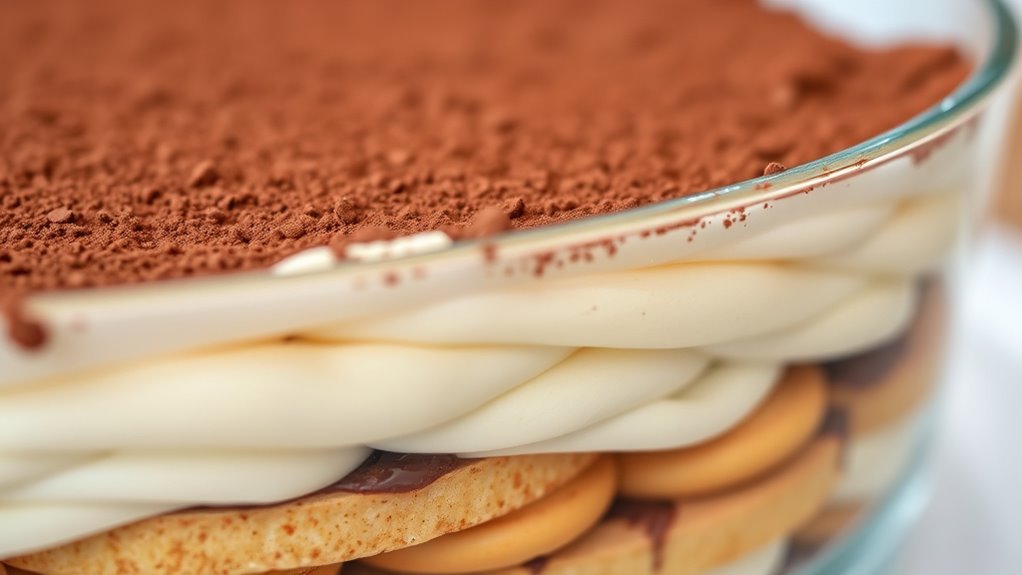To perfect tiramisu layering, start with high-quality ingredients like fresh mascarpone and strong, freshly brewed espresso. Dip ladyfingers briefly in hot coffee, aiming for just enough moisture without sogginess. Layer them evenly in your dish, add a smooth mascarpone mixture, and repeat until desired thickness. Finish with a cocoa dusting. Mastering these steps guarantees the ideal texture and flavor. Keep exploring to uncover more expert tips and techniques for exceptional results.
Key Takeaways
- Traditional tiramisu involves layering soaked ladyfingers with mascarpone mixture for balanced texture and flavor.
- Proper dipping of ladyfingers in espresso controls moisture, preventing sogginess and ensuring firmness.
- Gently folding ingredients and layering evenly enhances creaminess and visual appeal.
- Chilling for several hours allows flavors to meld and the dessert to develop optimal texture.
- Finishing with cocoa powder and optional garnishes adds authentic flavor and attractive presentation.
The Origins and Cultural Significance of Tiramisu
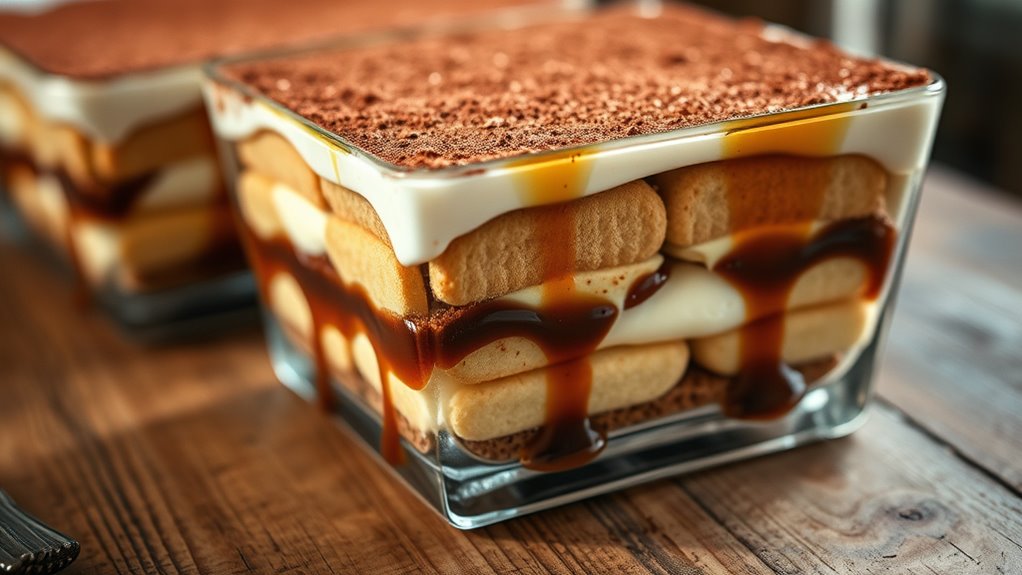
Tiramisu’s origins are a delicious blend of Italian tradition and innovation, with its roots tracing back to the Veneto region in northeastern Italy. You might imagine it as a dessert born from local culinary creativity, blending simple ingredients into something extraordinary. Historically, it’s believed to have emerged in the 1960s or 1970s, quickly gaining popularity across Italy and beyond. The name “tiramisu” means “pick-me-up,” reflecting its energizing combination of coffee, sugar, and cocoa. Over time, it became more than just a treat; it embodies Italian hospitality and the joy of sharing. Its cultural significance lies in its status as a symbol of regional pride and culinary ingenuity, celebrating Italy’s rich food heritage through a layered dessert that’s both comforting and elegant. Incorporating traditional culinary techniques has helped preserve its authentic flavor and appeal, especially methods like layering and soaking, which are essential to achieving its signature texture and taste. These techniques highlight the importance of attention to detail and precision in creating a truly authentic tiramisu. Additionally, understanding regional food traditions enhances the appreciation of its cultural roots and culinary artistry.
Selecting the Perfect Ingredients for Authentic Flavor
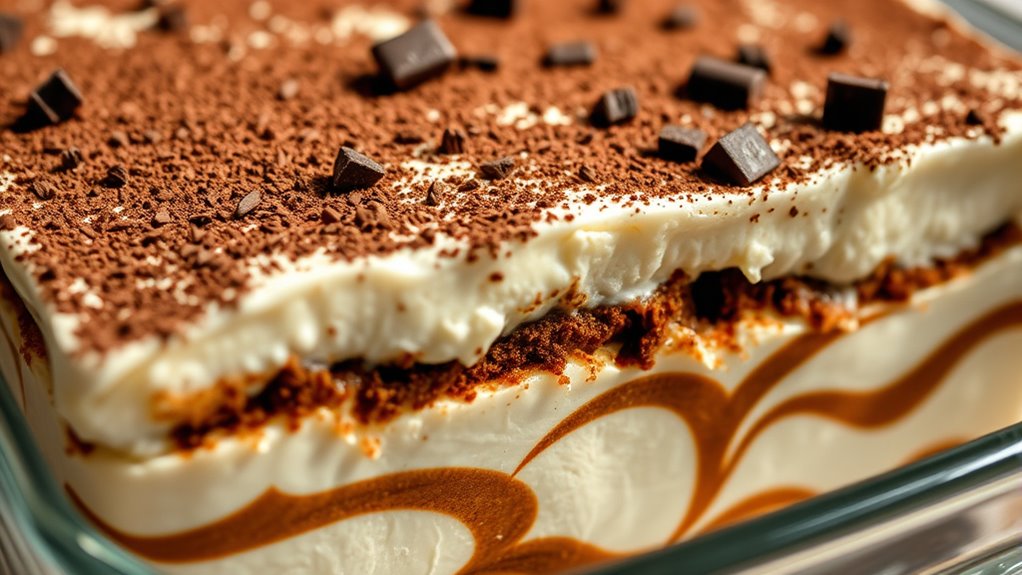
To achieve an authentic flavor, selecting high-quality ingredients is essential. Start with fresh, full-fat mascarpone cheese, which provides the creamy richness that defines true tiramisu. Use good-quality ladyfingers, preferably homemade or from a reputable bakery, to ensure the right texture and flavor absorption. When it comes to coffee, opt for freshly brewed espresso with a robust, slightly bitter profile to balance the sweetness. Don’t skimp on sugar—use superfine or powdered sugar for smoothness. For the cocoa powder, choose pure, unsweetened varieties to add depth without excess sweetness. Finally, select a good-quality liqueur, like Marsala or coffee liqueur, to enhance the aroma and layers of flavor. Sourcing high-quality ingredients makes all the difference in creating an authentic and delicious tiramisu. Additionally, selecting the right water-efficient kitchen appliances can help reduce overall household water consumption, aligning with eco-friendly practices. Incorporating leadership skills into your decision-making process ensures you make informed and strategic choices in your culinary pursuits. Using lifevest advisors can also help ensure your investment decisions in related areas are well-informed and secure. To further elevate your culinary craft, exploring keto diet apps can provide insights into nutrition and ingredient choices suitable for health-conscious cooking.
Preparing the Coffee and Soaking Ladyfingers

Start by choosing a strong, flavorful coffee that complements the mascarpone. Keep the soaking time just long enough for the ladyfingers to absorb the coffee without becoming soggy. Be careful not to over-soak, or your tiramisu might turn out too moist and lose its structure. Using the right brewing technique can help ensure your coffee has the ideal strength and flavor for soaking.
Choosing the Right Coffee
Choosing the right coffee is essential to achieving that perfect balance of rich flavor and smoothness in your tiramisu. Opt for a strong, freshly brewed espresso or a high-quality dark roast coffee. Avoid overly bitter or weak brews, as they can overpower the delicate mascarpone and ladyfingers. If you prefer a milder taste, consider using a blend with a subtle sweetness or adding a touch of sugar to the coffee. Using hot but not boiling coffee helps the ladyfingers absorb just enough moisture without becoming soggy. Remember, the coffee’s flavor should complement the creamy layers without dominating them. By selecting a robust yet balanced coffee, you ensure your tiramisu will have that authentic, irresistible coffee aroma and taste.
Optimal Soaking Duration
Getting the soaking just right is essential for achieving the perfect texture in your tiramisu. If you soak the ladyfingers too long, they become mushy and overpower the dessert’s structure. Too short, and they stay dry and crumbly. Aim for about 1-2 seconds per side, ensuring they absorb enough flavor without losing firmness. To help, consider this guide:
| Soaking Time | Result |
|---|---|
| 1-2 seconds | Lightly moist, firm |
| 3-4 seconds | Slightly softer, tender |
| 5+ seconds | Overly soaked, mushy |
Adjust based on your coffee’s strength and ladyfingers’ thickness. Practice a few dips to find your ideal balance for a luscious, well-textured tiramisu.
Preventing Over-Soaking
To prevent over-soaking your ladyfingers, focus on preparing your coffee correctly and controlling how long you dip each piece. Use a well-brewed, slightly cooled espresso or strong coffee, not piping hot, to avoid dissolving the cookies too quickly. When dipping, submerge each ladyfinger for about 1 to 2 seconds—no longer—just enough for them to absorb moisture without becoming soggy. Keep the coffee level shallow so you can easily control the exposure. If you notice the ladyfingers absorbing too much liquid or becoming limp, reduce the dipping time immediately. Remember, the goal is to moisten the cookies enough to hold the layers together, but not so much that they lose their structure and texture. Proper control ensures a balanced, delicious tiramisu. Additionally, understanding the mechanics of coffee brewing can help you select the perfect coffee for soaking, ensuring optimal flavor and consistency.
Crafting the Rich Mascarpone Mixture
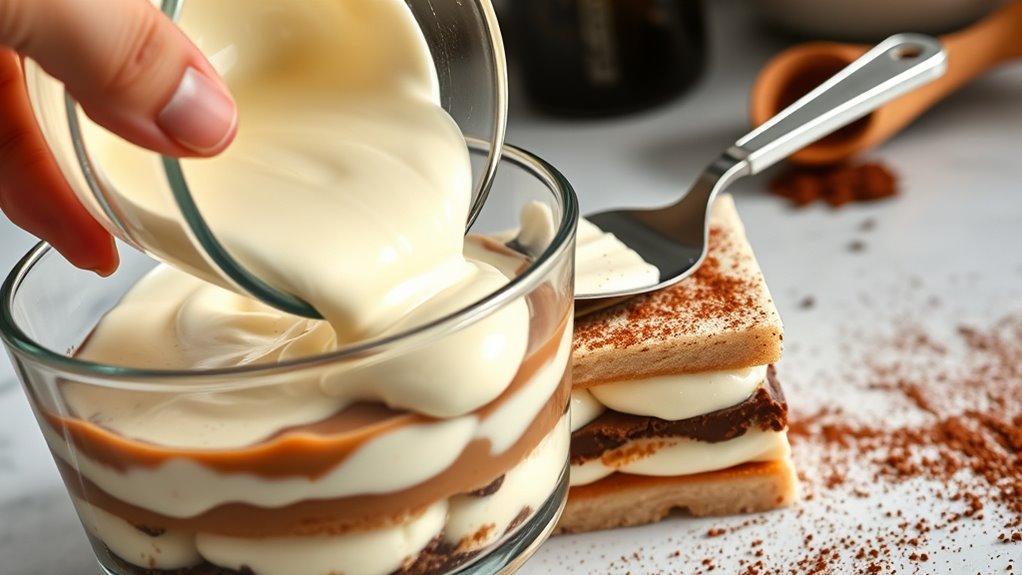
Creating a smooth, creamy mascarpone mixture is essential for achieving the authentic texture of tiramisu. To do this, start with high-quality mascarpone cheese and beat it gently until smooth. Next, fold in sugar gradually to ensure it dissolves evenly without lumps. For added richness, incorporate a splash of vanilla extract or a touch of liqueur like Marsala. Keep the mixture light by folding in whipped egg whites or heavy cream, depending on your recipe. Here are some tips to perfect your mascarpone:
- Use room temperature mascarpone for easier mixing.
- Gently fold ingredients to preserve airiness.
- Avoid overmixing to prevent a runny or dense texture.
This careful process results in a luscious, velvety mascarpone that elevates your tiramisu.
Assembling the Layers With Precision
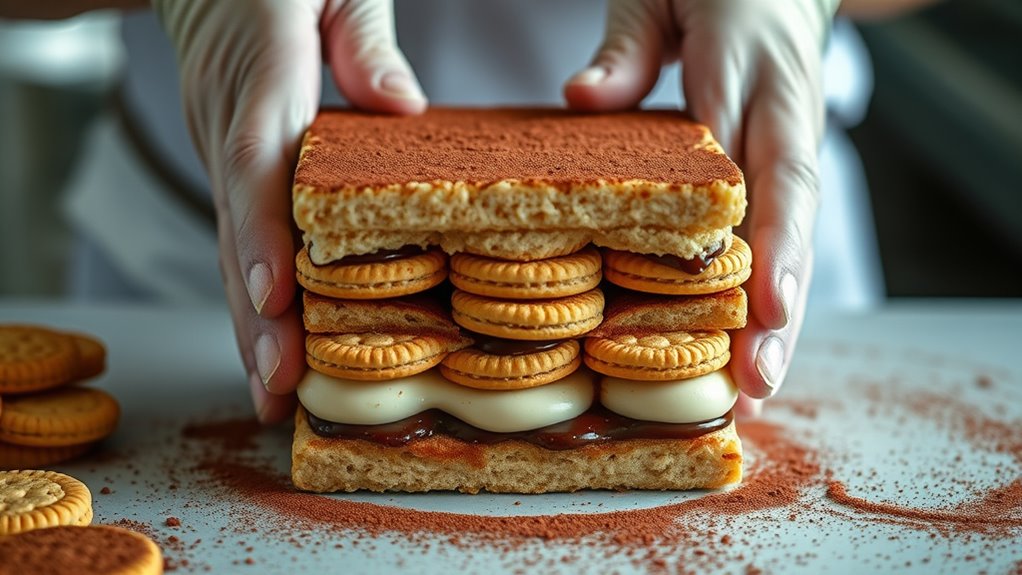
Assembling the layers with precision guarantees your tiramisu looks as beautiful as it tastes. Carefully layer the soaked ladyfingers first, then spread a generous layer of mascarpone mixture evenly. Repeat the process, making sure each layer is smooth and consistent. Use a spatula or the back of a spoon to level each layer, avoiding gaps or uneven spots. This attention to detail creates a visually appealing dessert and guarantees even flavor distribution. To help you stay organized, follow this simple guide:
| Step | Action |
|---|---|
| 1 | Lay soaked ladyfingers evenly |
| 2 | Add mascarpone layer |
| 3 | Repeat layers |
| 4 | Smooth each layer |
| 5 | Finish with a final layer |
Precision in assembly transforms your tiramisu into a stunning, professional-looking treat. Proper layering techniques are essential for achieving the perfect texture and appearance. Ensuring the consistency of layers not only enhances visual appeal but also guarantees a harmonious blend of flavors throughout the dessert. Additionally, maintaining the correct tire pressure during preparation can make handling the ingredients easier, especially when working with delicate layers.
The Art of Chilling and Serving Tiramisu
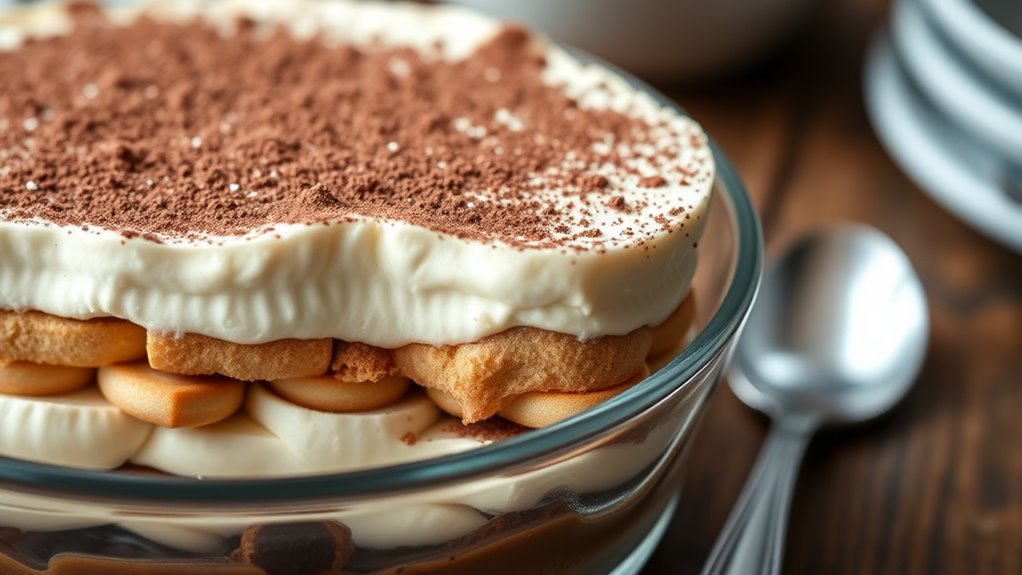
Once you’ve carefully assembled your tiramisu, the next essential step is chilling it properly to achieve the perfect texture and flavor. Proper chilling allows the flavors to meld and the mascarpone to set, making each bite smooth and balanced. Cover your dish with plastic wrap to prevent odors from seeping in, and refrigerate for at least 4 hours, ideally overnight. This ensures the ladyfingers soak up the coffee and liqueur fully, creating that signature moistness. When you’re ready to serve, take the tiramisu out of the fridge. For the best presentation, dust the top with cocoa powder just before serving. Remember these tips:
- Chill for a minimum of 4 hours, preferably overnight
- Cover tightly to prevent odors and drying out
- Dust with cocoa powder immediately before serving
- Proper chilling is essential for the right texture and flavor in your tiramisu.
Tips and Variations to Perfect Your Technique
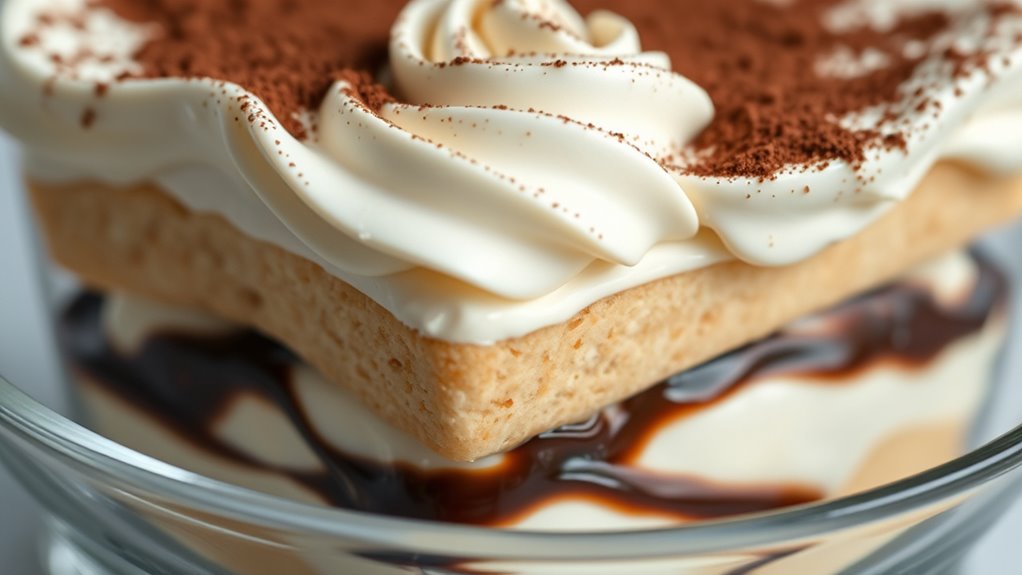
To perfect your tiramisu, experimenting with different techniques and ingredients can make a significant difference. Try soaking the ladyfingers in espresso that’s slightly stronger or flavored with a touch of liqueur like Marsala or Kahlua. Whipping the mascarpone mixture until it’s smooth and fluffy creates a lighter, creamier texture. You can also layer in variations such as adding fresh berries or a dusting of cocoa powder between layers for extra flavor. For a vegan version, substitute mascarpone with coconut cream and use plant-based biscuits. Adjust the sweetness to your taste, balancing the coffee bitterness with the sugar. Don’t be afraid to tweak the recipe until it suits your preferences, making each batch uniquely yours.
Frequently Asked Questions
What Are Common Mistakes to Avoid When Making Tiramisu?
When making tiramisu, you should avoid over-soaking the ladyfingers, as they can become soggy and lose texture. Don’t rush the chilling process; it helps flavors meld and sets the dessert properly. Also, steer clear of using low-quality mascarpone or skipping the dusting of cocoa powder, which enhances flavor. Finally, make certain you mix ingredients smoothly to avoid lumps, creating a creamy, balanced tiramisu every time.
How Can I Make a Gluten-Free or Vegan Tiramisu?
Imagine you’re in a 1920s speakeasy, but instead of alcohol, you’re crafting a gluten-free or vegan tiramisu. You can swap traditional ladyfingers for gluten-free or vegan-friendly biscuits, and use coconut cream or cashew cheese instead of mascarpone. Coffee, cocoa, and sweeteners stay the same. With these substitutions, you create a delicious, allergy-friendly dessert that respects tradition while embracing modern dietary needs.
What Are Alternative Ingredients for Traditional Mascarpone Cheese?
You’re wondering what alternatives you can use instead of traditional mascarpone cheese. You can try blending softened cream cheese with heavy cream or Greek yogurt for a similar creamy texture. Vegan options include blended cashews or coconut cream, which mimic mascarpone’s richness. These substitutions work well and let you customize your tiramisu to fit dietary needs while keeping that luscious, smooth consistency you love.
How Do Different Regional Variations of Tiramisu Differ in Technique?
You explore how regional tiramisu variations differ in technique by noticing changes in layering, soaking, and ingredients. In some places, you might use ladyfingers soaked in different spirits or coffee blends, while others layer more or fewer times. You might also see variations in whipping the cream or incorporating local flavors. These differences reflect local tastes and traditions, making each regional tiramisu unique in its preparation and presentation.
What Equipment Is Essential for Achieving Perfect Layers?
Think of your kitchen as a stage where perfect tiramisu layers perform seamlessly. You need a steady hand and essential equipment like a shallow dish for even layering, a spatula to smooth each layer, and a fine sieve for dusting cocoa powder. A quality whisk or hand mixer helps blend mascarpone smoothly. With these tools, your tiramisu will shine, showcasing impeccable layers that delight every sense.
Conclusion
Now that you’ve mastered the art of layering and chilling, your tiramisu will be a symphony of flavors and textures. With each spoonful, you’ll taste the rich history and meticulous techniques woven into every layer—like a carefully crafted tapestry. Remember, patience and precision are your best tools, turning simple ingredients into a decadent masterpiece. So, embrace the process and let your passion shine through, creating a dessert that’s truly a feast for the senses.
